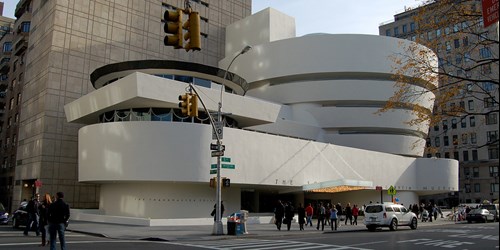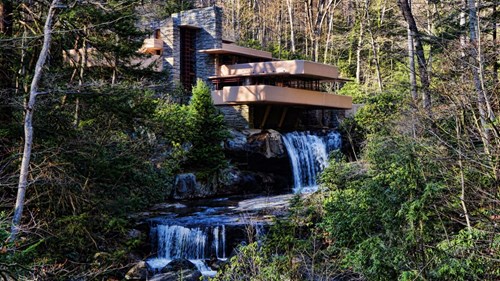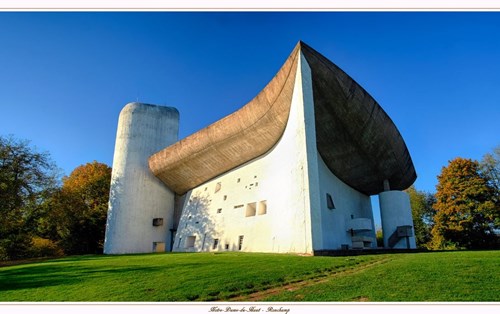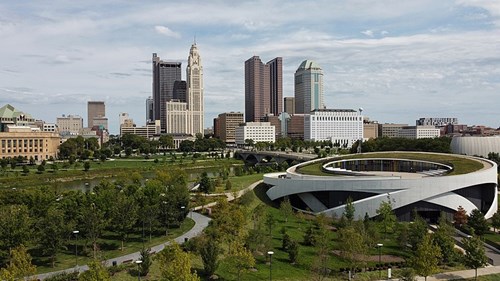What is Organic Modernism?
Organic modernism architecture is a philosophy of architecture which promotes harmony between human habitation and the natural world. Organic designs allow for buildings to be built within and alongside nature, instead of against it. The idea is to coexist with our natural environment, using sustainable design and natural materials. Doing so allows us to stay in touch with our environment instead of disconnecting from it.
Components of Organic Modernism:
- Natural colors and aesthetics
- Complimenting the surrounding environment
- Simplicity in its designs
- Sustainable architecture
Featured Examples of Organic Modernism Architecture
There are so many examples of this style, but here are just a few featured projects to give you a glimpse into the world of organic modern architecture.
Solomon R. Guggenheim Museum

The Solomon R. Guggenheim Museum is an art museum located in New York City, housing a collection of mostly contemporary art collected by Solomon R. Guggenheim. The building, designed by renowned architect Frank Lloyd Wright in 1943, is made up of 3 distinct formations: two rotundas and a rectangular slab underneath them. It’s main focus is a large, circular ramp that rises along the inside of the largest rotunda, allowing for a seamless view of the art collection.
Nature is the key feature of the building. The circular shape of the building appears to grow from the ground, giving it a look of natural beauty. The ceiling of the main museum area is a 90ft oculus that fills the space with natural light. Additionally, nature is featured within the design: light, plants, and water all feature heavily in the building. “Study nature, love nature, stay close to nature. It will never fail you.” -Frank Lloyd Wright
Photo by Sam Valadi [Photo source]
Further reading: The Architecture of the Solomon R. Guggenheim Museum
Fallingwater

One of the most famous buildings designed with organic modern architecture is Fallingwater. The residential building was designed by Frank Lloyd Wright – who is known to be the master of organic modernism. The home was designed to encompass the surrounding waterfalls in an organic way, allowing for comfortable living among nature, without disrupting it.
Other interesting design elements with this is the use of straight lines, which highlight the more organic shapes of the surrounding environment. Rough, vertical masonry piers give a natural organic shape to contrast the smooth, horizontal platforms. Additionally, the use of cantilevers (a long, projecting object which is supported only on one end) give the illusion of hovering platforms above the flowing waters below.
Photo by Mariano Mantel [Photo source]
Further reading: Fallingwater.com
Chapelle Notre Dame du Haut

Designed by Le Corbusier in 1959, the Chapelle Notre Dame du Haut was built on a hilltop in Ronschamp, France. A more classic chapel was previously located on the site, but the building had been destroyed during World War II.
While Le Corbusier’s designs typically leaned more clean-lined and functional, this design features convex and concave shapes throughout the exterior and interior. The chapel is made up of thick masonry walls that reach a point that moves upward, evoking the feeling of a billowing ship. The curved concrete roof, separated from the walls below by a small gap, give the feeling of a cloud floating gently above. The gap creates a sliver of light in the interior, running along the ceiling to bring natural, subtle light in the space.
Photo by LauterGold [Photo source]
Further reading: Le Corbusier's Ronchamp chapel is one of the 20th century's most important buildings
The Kellogg Doolittle Residence
Ken Kellogg, a mentee of Frank Lloyd Wright, designed a new residence for the Doolittles in 2005. Nestled onto a desert hillside on the edge of Joshua Tree National Park, the design mimics the ancient rock formations that surround it, giving the illusion of a smoothened boulders, or even perhaps ancient bones found in the rocks. The interior contains no lumber or drywall, instead only stone, concrete, copper and glass. Kellogg is known to use contradictions in his designs: Brutalism with Organic Modernism, and using glass and stone to create warmth. Even with this tension, the form can be seen as completely reflective of its surrounding environment.
[Further reading: Kelloggdoolittlehouse.com ]
National Veterans Museum

A standout piece of architecture located in downtown Columbus, Ohio, the National Veterans Memorial and Museum is a stunning piece of organic modern architecture. The crux of the design is a spiral procession gliding upwards, leading toward a grass-covered rooftop sanctuary. As many veterans may have difficulty walking, the importance of ramps was not overlooked. The spiral ascension is not only beautiful, but more importantly, gives differently abled people access to the amenities.
Photo by J. Jessee [Photo source]
Further reading: nationalvmm.org: About The Architecture
Conclusion
While at first glance organic modernism can seem unconventional, the beauty of our natural environment should be allowed to inspire our own living spaces. From museums to churches to homes, we can find a way to coexist in beautiful spaces not against nature, but alongside it.


